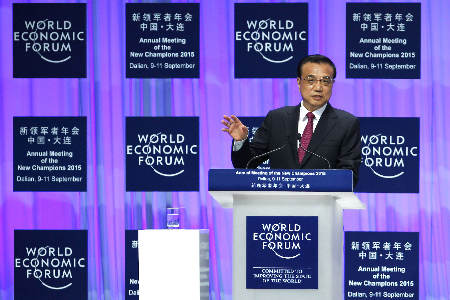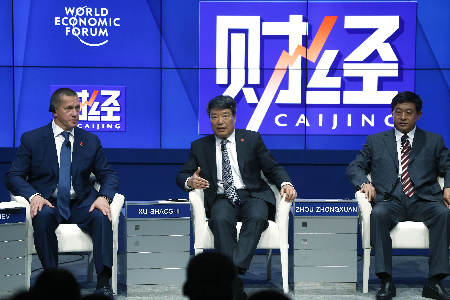China’s Growth Momentum Foreseen at Summer Davos
By staff reporter XING WEN
 |
| Chinese Premier Li Keqiang delivers a speech at the opening ceremony of the Ninth Summer Davos Forum in Dalian on September 10, 2015. |
IT is an irrefutable fact that the global growth rate has been declining since the financial crisis broke out in 2008. Under the theme of “Charting a New Course for Growth,” more than 1,700 participants from over 90 countries and regions discussed the new challenges the world economy is facing during the World Economic Forum’s Annual Meeting of the New Champions 2015, or the Ninth Summer Davos Forum in Northeast China’s port city of Dalian last September. Against the backdrop of intricate external conditions and downward pressure at home, China’s economy touches a global nerve. It is no wonder then that the Chinese economy was a recurring topic during the annual meeting.
Underlying Trend Remains Positive
As the world’s second largest economy, China greatly influences the global economic trend. Since global economic recovery is still weak, many international institutions have accordingly downgraded their global economic forecast. China, at the same time, has lowered its GDP growth target and entered its “new normal” period. Nevertheless, a slowdown in growth rate and declining macroeconomic indicators do not imply that the Chinese economy will head for a “hard landing.” Wang Hongzhang, president of China Construction Bank Corp., compared the “new normal” with a change in speed of a traveling train – neither a stop, nor a “tumble from a cliff.”
As a matter of fact, the fundamentals underpinning a stable Chinese economy have not changed. The Chinese economy is going through a transition, with traditional drivers being replaced by new ones. Ups and downs in growth are hardly avoidable during this stage. When he met with domestic and foreign business representatives at the Summer Davos forum, Chinese Premier Li Keqiang said that the “shape” of the Chinese economy is characterized by ups and downs, but the underlying trend remains positive. First, the extensive model of growth in the manufacturing sector is giving way to more intensive production, and over-reliance on investment has been replaced by greater balance between consumption and investment, which have brought about a “curving wave.” This is a transitional yet painful process in which ups and downs in growth are inevitable. Second, the ongoing structural reform has already yielded encouraging results. At present, consumption contributes 60 percent to total growth – the service industry now accounts for half of China’s GDP – and growth rate in hi-tech industries has surpassed 10 percent. Demands on the information, culture, health care, and tourism sectors are booming while the industries relating to energy conservation and green economy are making substantial progress. New economic growth points are rapidly taking shape. “The ‘new normal’ does not only mean a lower growth rate, but a different growth mode,” commented Feike Sijbesma, CEO of Royal DSM.
Despite the slowdown in global growth, China contributed about 30 percent to global growth in the first half of this year. In the same period, the country achieved a seven-percent growth, one which is among the highest of the world’s major economies. In addition, 7.18 million new urban jobs were created in the first six months, and per capita disposable income grew faster than the economy growth rate. All these factors serve to prove that the Chinese economy is still within the reasonable range. In his speech at the opening ceremony of this year’s Summer Davos, Premier Li Keqiang noted that China is not a source of risk for the world economy but a real source of strength for world economic growth. He went on to say that the Chinese economy is supported not by a single pillar but by multiple pillars, which means it is highly resilient and shock-resistant.
The policies and measures adopted in the past are starting to pay off, and positive factors are accumulating. Since last May, major economic indicators in the fields of industry, investment, consumption, and import and export have been stable and moving in a positive direction. “We are capable of meeting the main goals and tasks set for economic and social development this year, and this will lay a solid foundation for sustainable growth in the years to come.” The Premier’s remarks thus expressed great confidence.
 |
|
Xu Shaoshi (middle), minister in charge of China’s National Development and Reform Commission, Russian Deputy Prime Minister Yury Trutnev (left), and Zhou Zhongxuan, vice governor of Liaoning Province, talk at the forum about the prospect of China’s industrial cooperation. |
Mass Entrepreneurship and Innovation
Entrepreneurship has always been highly advocated by the World Economic Forum’s Annual Meeting of the New Champions. Today in China, hundreds of thousands of entrepreneurs and innovators are the new champions, representing the hopes of future economic development.
At last year’s Summer Davos, Premier Li Keqiang raised the idea of mass entrepreneurship and innovation. In the government report delivered in March 2015, mass entrepreneurship and innovation was defined as one of the “twin engines” to facilitate economic transformation and ensure growth. Over the year, the country has witnessed a boom in entrepreneurship and innovation, both of which have continued to vitalize the economy. In 2014, the number of newly founded companies in China surged to 3.65 million, which means 10,000 new businesses were registered daily. New jobs were consequently created. Statistics released by The Economic Observer show that nearly 10 million people were involved in entrepreneurship and employment in the Internet industry in 2014. Increasingly more college graduates, returned overseas students, technical experts, and senior managers are joining the ranks of entrepreneurship and innovation. Meanwhile, the platforms for entrepreneurship and innovation are diversifying, so attracting small and micro companies as well as big corporations. New concepts such as crowd outsourcing and crowd funding have been set up, changing the modes of production and management.
At this year’s forum, Premier Li Ke-qiang stressed that mass entrepreneurship and innovation constituted a major part of China’s ongoing structural reform and adjustment. They also drive development and generate more employment, give impetus to developing a shared economy, represent an innovative step in the income distribution model, and help put in place a more equitable distribution pattern. Although difficulties remain for the Chinese economy, creativity and entrepreneurial passion have enhanced people’s confidence that they can overcome challenges.
Moreover, supporting measures have been launched to encourage mass entrepreneurship and innovation. For instance, steps have been taken to streamline administration, delegate government power, cut taxes and fees for small and micro enterprises, and establish investment funds for entrepreneurship. On top of that, market access for foreign investment in this field has been relaxed to some extent while management systems of foreign venture capital investment are improving. At the same time, domestic organizations are encouraged to invest in overseas high-end research and development projects and share their achievements.
It is believed that further reforms in various sectors will facilitate entrepreneurship and innovation and promote economic development.
New champions engaging in mass entrepreneurship and innovation are part of the new blueprint for growth in China and beyond, and are creating ample opportunities.
 |
| More than 1,700 participants from over 90 countries and regions attend the forum with the theme “Charting a New Course for Growth.” |
A Community of Common Interests and Development
The concept of a community of common interests and development was initiated by Premier Li Keqiang at this year’s Summer Davos. China is the biggest developing country in the world, and development holds the key to resolving all issues in China. The country’s steady economic development has benefited both the Chinese people and people of the world. For example, having become a net capital exporter in 2014, China’s outbound investment has maintained rapid growth. In addition, the number of outbound tourists has notably increased. Last year alone, Chinese tourists made over 100 million trips overseas. In the first half of this year, the number rose by 10 percent year-on-year. What’s more, amid a slowdown of global trade, the actual amount of bulk commodities China imports has continued to rise.
China has made remarkable achievements over the past decades and its economy is deeply integrated into the global market. Given the weak growth of the global economy, there was no way China could escape unscathed. In the meantime, problems due to unbalanced development worldwide are thrown into sharper relief. Hence, “a community of common development” presents a new philosophy to establish a new world pattern. Following this concept, global cooperation on production capacity is expected to forge a more balanced and inclusive global industrial chain and foster a global community of common interests and development for win-win, inclusive, and common progress.
Ventures in global cooperation on production capacity and equipment show that China has seized the opportunity of industrial division. According to Xu Shaoshi, minister in charge of the National Development and Reform Commission, today’s China cannot fully rely on the export of consumer products to increase its export demands. After 30 years of reform and opening-up, the country is deeply involved in the global economy and owns complete and comprehensive systems and rich production capacities.
He also noted that global cooperation in production capacity and equipment is expected to facilitate the recovery of the world economy. Developing countries need a large amount of infrastructure. Though developed economies boast advanced technology and management, they often incur high costs. However, China has the ability to integrate demand and supply and push forward cooperation in industrial capacity on a large scale, so adding new drivers to the recovery of the global economy.
Promoting global cooperation in production capacity will produce multiple benefits and win-win results among all parties. Up to now, China has selected 15 countries willing to cooperate with China, which signifies a solid foundation for cooperation. Meanwhile, some countries like Kazakhstan have been chosen to launch several projects in line with the Belt and Road Initiative.
At this year’s forum, the world learned about China’s current economic situation, which is moving in a positive direction, and is assured that the country will stick to its opening-up strategy based on a mutual benefit and win-win principle. With enormous potential and bright prospects, China’s economic progress will generate increasingly more opportunities for the whole world.
